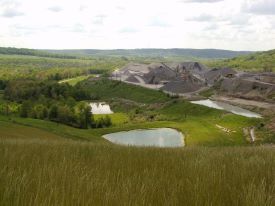Aggregates and industrial sand producers are proactive members of their communities. Operators ensure closed sites are responsibly reclaimed and add community benefits once extraction is completed. Reclaimed quarries can take many forms depending on where they are located, including farmland, parks, wildlife habitat areas, water reservoirs, community developments, recreation spots, nature preserves and alternative energy generation.
NSSGA members are effective stewards of the land. They value innovation that enhances sustainability throughout the supply chain and creates state-of-the-art solutions that improve our homes, businesses and schools. For example, finding environmentally and socially beneficial strategies to utilize quarry fines (traditionally a waste material) in road construction, as a soil enhancement, or sequester of carbon. NSSGA supports incentive-based programs and a flexible sustainability strategy that allows our members to increase their operations’ sustainability during extraction and reclamation based on the individual needs of each business.


